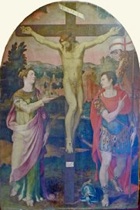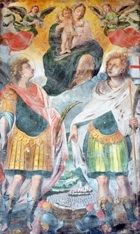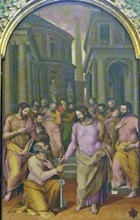Livio Agresti was born in Forlì and worked mainly in Rome, where he trained under Perino del Vaga. He enrolled in the Accademia di San Luca there in 1534. According to Giorgio Vasari (with whom he worked in both Rome and Florence), “his first works, which are in Narni, have in them not a little of the good”.
Amelia
Apart from the works below, Livio Agresti is known to have worked in the Palazzo degli Anziani in 1570-2, but this work was lost when the palace collapsed in 1817.
Crucifixion with SS Firmina and Olympias (1557)

Beheading of St John the Baptist (1571)
This altarpiece in the ex-church of San Giovanni Decollato is signed by Livio Agresti and dated by inscription. It was presumably commissioned to mark the incorporation of the Confraternita della Misericordia into the Arciconfraternita di San Giovanni Decollato, Rome in 1570 and the rededication of their church (previously di Santa Maria dei Laici, della Misericordia or dell’ Ospedaletto).
Frescoes of Palazzo Petrignani (begun in 1572)
The frescoes of Palazzo Petrignani, which were, are difficult to attribute because almost all of them derive from engravings of well-known works in Rome. They are sometimes attributed to the Zuccari brothers because some of them are based on engravings of works by these artists. It is more likely that they were the work (at least in part) of Livio Agresti, who was documented in Amelia at this time. They may well have been continued by Litardo Piccioli the local artist to whom Agresti bequeathed “his paints and other things” in his will of 1575.
Madonna and Child with saints (16th century)

Frescoes of Palazzo Boccarini (16th century)
Frescoes in the Salone Amerino of Palazzo Boccarini are attributed to Livio Agresti. They include allegories of Amelia as “Madre Terra” and “Città Forte”.
Narni
Annunciation (1559)

Consignment of the Keys (1560)

Terni
Circumcision of Christ (1560)




